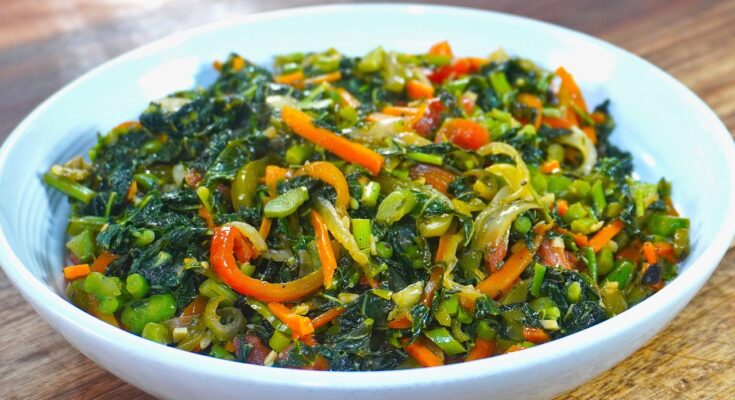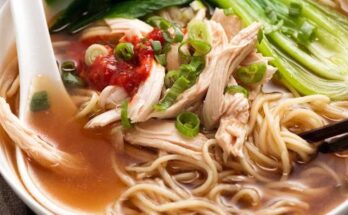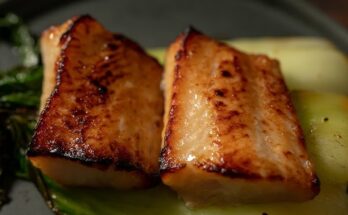Callaloo Recipe: Callaloo isn’t just food—it’s a cultural symbol wrapped in the comfort of home-cooked love. It’s a classic Caribbean dish made from leafy greens and cooked down with a flavorful mix of aromatics, herbs, and sometimes meats or seafood. The beauty of callaloo lies in its simplicity and versatility. Depending on where you’re from, it might look or taste slightly different, but the soul of the dish remains the same.
This dish is a staple in many Caribbean homes, especially in places like Jamaica, Trinidad and Tobago, Dominica, and St. Lucia. It’s hearty, flavorful, and often served as part of a larger meal—think saltfish and dumplings or fried plantains. Whether you’re trying Caribbean food for the first time or reconnecting with your roots, learning how to make callaloo is a must.
Origins and Cultural Significance
The roots of callaloo stretch deep into West Africa, making their way to the Caribbean during the transatlantic slave trade. Over time, each island infused the dish with local herbs, vegetables, and cooking methods. Today, callaloo is much more than a green soup or side dish—it’s a symbol of Caribbean identity, heritage, and resilience.
In Jamaica, callaloo is often eaten for breakfast, while in Trinidad, it’s part of the traditional Sunday lunch, cooked down with okra and coconut milk. In Grenada, you’ll see callaloo used in “oil down,” their national dish. For many Caribbean families, callaloo isn’t just food—it’s nostalgia, tradition, and comfort all in one bowl.
Different Variations Across the Caribbean
Callaloo comes in many forms depending on where you’re eating it:
- Jamaican Callaloo: Uses the amaranth plant, sautéed with onion, scallions, tomatoes, and sometimes codfish.
- Trinidadian Callaloo: More of a soup or stew, made with dasheen bush (taro leaves), okra, coconut milk, and pimento peppers.
- Dominican Callaloo: Sometimes includes spinach or other leafy greens, often combined with meats or seafood.
- Grenadian Callaloo: Typically features in “oil down,” a one-pot dish with breadfruit, salted meat, and coconut milk.
Despite the differences, the common thread is the use of leafy greens cooked until tender and flavorful. That’s the essence of callaloo.
Health Benefits of Callaloo
Not only is callaloo tasty—it’s also a powerhouse of nutrients. Whether you use amaranth leaves, taro leaves, or spinach, you’re getting a dose of:
- Iron: Great for boosting energy and fighting fatigue.
- Fiber: Helps keep your digestion smooth.
- Calcium and Magnesium: Important for strong bones and muscles.
- Antioxidants: Helps fight inflammation and boost immunity.
It’s also low in calories and high in vitamins A, C, and K. If you’re looking for a way to add more greens into your diet without sacrificing flavor, callaloo is a great place to start.
Essential Ingredients for Callaloo
Let’s talk ingredients. The key to great callaloo is fresh, flavorful components. Here’s what you’ll need:
Leafy Greens (Callaloo or Substitute)
- Amaranth leaves (traditional Jamaican)
- Dasheen or Taro leaves (Trinidadian style)
- Spinach or kale (easier to find substitutes)
Aromatics and Flavor Builders
- Onion
- Garlic
- Scallions (green onions)
- Thyme
- Pimento or scotch bonnet pepper (adds heat and flavor)
- Tomatoes (optional for a juicy base)
Proteins (Optional but Popular Additions)
- Saltfish (codfish) – adds saltiness and protein
- Crab or smoked turkey (used in Trinidad and Grenada)
- Shrimp (a nice twist)
Coconut Milk: A Creamy Base
- Adds body, richness, and tropical flavor
- Especially used in Trinidadian and Grenadian callaloo recipes
Kitchen Tools You’ll Need
Cooking callaloo doesn’t require fancy tools, but a few basics will make your job easier:
- Large pot or Dutch oven
- Cutting board and sharp knife
- Wooden spoon or spatula
- Blender (optional, if you want a smoother texture)
- Strainer (to rinse leaves)
Having the right tools makes the prep and cooking process smoother—and a lot more fun!
How to Choose Fresh Callaloo Leaves
If you’re lucky enough to live near a Caribbean market, fresh callaloo leaves may be available. Here’s what to look for:
- Bright green, unbruised leaves
- Firm stems, not wilted or slimy
- No yellowing or dark spots
Can’t find them? No worries—spinach or kale works just fine and still brings that green, earthy flavor to the dish.
How to Clean and Prep Callaloo Leaves Properly
Washing and prepping your greens is a big deal—don’t skip this!
- Trim the stems: Remove any tough or woody parts.
- Rinse thoroughly: Soak in cold water and swish around to remove dirt or bugs.
- Chop finely: Small pieces cook down better and blend with the dish more smoothly.
Repeat the rinse if necessary. Clean greens make all the difference in flavor and texture.
Step-by-Step Callaloo Recipe Guide
Let’s break it down step by step so you can master this dish on your first try.
Step 1: Prep Your Ingredients
Before you start cooking, have everything ready:
- 4 cups callaloo or spinach, chopped
- 1 small onion, diced
- 2 scallions, chopped
- 2 cloves garlic, minced
- 1 sprig thyme
- 1/2 cup coconut milk
- 1 scotch bonnet (whole or chopped, optional)
- Salt and pepper to taste
- Optional: 1/2 cup cooked saltfish or crab meat
Step 2: Sauté the Flavor Base
In a large pot, heat a little oil over medium heat. Add the onion, scallions, and garlic. Sauté until fragrant and soft—about 3 to 5 minutes. This step is crucial because it builds the foundation of flavor.
Next, toss in the thyme and tomato (if using). Stir for another minute or two until the tomato begins to break down. If you’re adding saltfish, now’s the time to add it.
Step 3: Add Callaloo Leaves and Cook Down
Pile in your chopped callaloo leaves. At first, it might seem like too much, but don’t worry—it cooks down fast. Stir well to coat the leaves in all those beautiful flavors from your sauté.
As it begins to wilt, lower the heat slightly and let it cook for 10 to 15 minutes. Stir occasionally to prevent sticking or burning.
Step 4: Add Liquid and Simmer
Now it’s time for the coconut milk. Pour it in, stir well, and let everything simmer for another 10 minutes. The coconut milk softens the greens even more and adds a rich, velvety flavor that makes the dish shine.
Add salt, pepper, and your scotch bonnet (if you like it spicy). Simmer uncovered until the callaloo is tender and the flavors are well combined.
Step 5: Blend (Optional)
Some like their callaloo chunky; others prefer it smooth. If you want a creamy consistency like in Trinidad-style callaloo, use an immersion blender or regular blender (cool slightly first!) to purée the mixture. This gives you a thick, soup-like texture that’s perfect with rice or bread.
Serving Suggestions
Now that your callaloo is ready, the question is—how are you going to serve it? This dish is as versatile as it is delicious. Depending on where you’re from (or your mood), you can pair it with a variety of sides and mains. In Jamaica, callaloo is often served as a breakfast item alongside fried dumplings, boiled green bananas, or breadfruit. In Trinidad, it’s typically part of a hearty Sunday lunch, paired with rice and stew chicken, macaroni pie, or plantains.
You can also serve callaloo as:
- A standalone soup with a slice of hard dough bread or crackers
- A side dish next to grilled or fried fish
- A topping for toast or rice bowls for a healthy twist
- A filling for savory pastries like patties or empanadas
Don’t be afraid to get creative. Callaloo is like that one friend who gets along with everyone—it blends well with a variety of flavors.
What to Serve With Callaloo
Looking for the perfect companion dishes to make it a full meal? Here are some popular pairings:
- Saltfish (Ackee and Saltfish or Plain Saltfish)
- Rice and Peas – especially with a dollop of callaloo on top
- Boiled provisions – yam, green banana, cassava
- Stewed chicken or beef – for a full Caribbean dinner experience
- Hard dough bread – a slightly sweet bread that pairs perfectly with the savory callaloo
Pairing is all about balance. The creamy texture of callaloo complements starchy or crispy sides wonderfully. And if you’re hosting a Caribbean-themed dinner night, serving callaloo is an authentic way to impress your guests.
Storage and Reheating Tips
Got leftovers? Great! Callaloo stores well and often tastes even better the next day when all the flavors have had more time to develop. Here’s how to store and reheat it properly:
Refrigeration:
- Store in an airtight container.
- Keep for up to 4–5 days.
- Let it cool before sealing and refrigerating.
Freezing:
- Yes, you can freeze callaloo!
- Use freezer-safe bags or containers.
- Best used within 2 months for optimal flavor.
Reheating:
- Reheat in a pot over low to medium heat.
- Add a splash of water or coconut milk if it looks too thick.
- Microwave-friendly too—just stir halfway through to avoid cold spots.
Make a big batch and enjoy throughout the week—it’s meal-prep friendly and freezer-safe!
Common Mistakes to Avoid
Even though callaloo is fairly simple to make, a few common missteps can trip you up. Here’s what to watch out for:
- Not washing the leaves properly: Grit or bugs can ruin the texture.
- Overcooking the greens: You want them tender, not mushy.
- Skipping the aromatics: Onion, garlic, thyme, and scallions are non-negotiable for great flavor.
- Not balancing the heat: Scotch bonnet is traditional but strong—use wisely.
- Adding too much liquid: Especially if you’re not blending, this can turn your dish into soup (unless that’s your goal).
Learning from these mistakes early helps you master the art of Caribbean cooking faster and with fewer kitchen disasters.
Callaloo Recipe Variations
Callaloo isn’t one-size-fits-all. Depending on your taste, diet, or regional influence, you can tweak it in plenty of delicious ways. Here are a few ideas:
- Vegan Callaloo: Skip the meat or fish, and lean into coconut milk, garlic, and spices for deep flavor.
- Spicy Callaloo: Add extra scotch bonnet or a splash of pepper sauce if you’re feeling brave.
- Seafood Callaloo: Toss in shrimp or crab for a coastal twist.
- Chunky or Creamy?: Blend it for soup-style or leave it chunky for a sautéed side dish.
The best part? Once you learn the base recipe, you can experiment freely and tailor it to your own style.
Why You’ll Love Making This at Home
There’s something magical about bringing a dish like callaloo to life in your own kitchen. It’s not just about cooking—it’s about culture, flavor, and connection. Whether you’re reliving a childhood memory, exploring Caribbean cuisine for the first time, or just trying to eat more greens, callaloo delivers.
- It’s budget-friendly. Most ingredients are accessible and affordable.
- It’s quick. You can have a full meal or side dish ready in under 30 minutes.
- It’s customizable. Vegan? Spicy lover? Seafood fanatic? There’s a callaloo version for you.
- It’s healthy. Packed with fiber, vitamins, and good fats (thanks, coconut milk!).
Once you’ve made it once, it becomes a go-to comfort food you’ll return to again and again.
FAQs about Callaloo Recipe
1. What is a good substitute for callaloo leaves?
If you can’t find traditional callaloo leaves like amaranth or dasheen bush, spinach, kale, or even Swiss chard are excellent alternatives. They give a similar texture and absorb the flavors beautifully.
2. Is callaloo spicy?
It can be—but only if you want it to be. Scotch bonnet peppers are often used for heat and flavor, but you can easily tone it down or omit the pepper altogether if you prefer a milder dish.
3. Can I make callaloo vegan?
Absolutely! Just skip the saltfish or meat, and focus on coconut milk, fresh greens, herbs, and spices. It’s just as flavorful and satisfying, minus the animal products.
4. How long does callaloo last in the fridge?
Properly stored in an airtight container, callaloo can last up to 4–5 days in the refrigerator. Reheat as needed on the stovetop or in the microwave.
5. Can I freeze callaloo?
Yes, it freezes well! Let it cool completely before transferring to freezer-safe containers. Use within 2 months for best quality.
Conclusion
Callaloo is more than just a Caribbean staple—it’s a dish steeped in history, flavor, and soul. Whether you’re making it the Jamaican way with amaranth leaves or going the Trinidadian route with dasheen bush and coconut milk, one thing’s certain: this green goodness will steal the show at any meal. With its bold flavors, nutritional value, and cultural richness, callaloo deserves a spot on your table.
From weekend brunch to a cozy dinner, or as a bold addition to a celebration meal—there’s always a reason to make callaloo. So why not start today?



